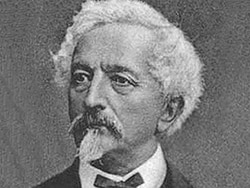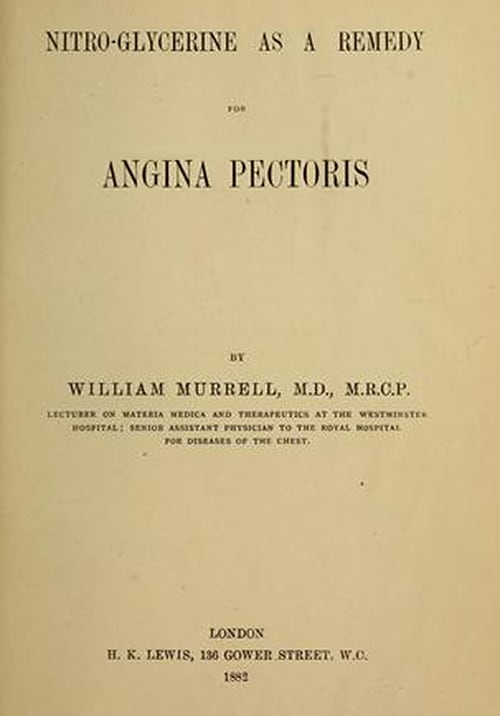Nitrate medications are notorious for being able to trigger airport bomb detection scanners and to alert explosive-sniffing dogs, a reminder of the origins of this extremely useful medication.
Let’s have a blast and review how this explosive became a cardiac drug.
Glyceryl trinitrate, or NTG, first entered the scene in the 1840s, when an Italian chemist, Ascanio Sobrero, created it by adding nitric acid and sulfuric acid to glycerol. The instability of this oily liquid is the reason it was often the weapon of choice for classic cartoon villains that you may remember fondly from childhood.
It was Alfred Nobel (of the eponymous Prizes fame) who combined the otherwise unstable explosive NTG with an inert adsorbent, kieselguhr, creating a paste that could be packaged in sticks and detonated in a controlled way.
Today NTG is a vasodilator, a very potent one that typically is administered sublingually to relieve and prevent attacks of angina.

Ascanio Sobrero
The transformation of this explosive into a medicine that has helped millions, might have consoled Sobrero, who would come to regret inventing NTG. Apart from being injured and scarring himself from an NTG explosion in the lab, Sobrero would see his invention harming and killing others. His regret only worsened after Nobel made NTG commercially viable.
Although Sobrero would live until 1888, by which time the world of medicine was at least dabbling with NTG as a cardiac drug, the drug would not begin flourishing as a pharmaceutical until the early 1900s. This medical dabbling began with an action that Sobrero himself took prior discovering NTG’s explosive property. He put a bit of it on his tongue, just to have a taste.
Keep in mind that this was the mid-19th century, when it was common for chemists to use their mouths as instruments the way that we might use a pH meter, or a photospectrometer. This was an era in which people sniffed nitrous oxide, ether, and chloroform for entertainment — leading to serendipitous medical discoveries — and that’s what happened with NTG.
Sobrero learned that NTG tasted sweet and that it gave him massive headaches. Initially, this observation interested homeopaths, who reasoned that small fractions of the dose that caused headaches might cure headaches, so they tried that. It didn’t work, of course, but as the drug got around it was observed to lower blood pressure, so some physicians started using it as treatment for hypertension.
Meanwhile, people were getting headaches from sniffing fumes of another recreational substance, amyl nitrite. When researchers realized by the late 1860s that amyl nitrite was a vasodilator, it caught the eye of T. Lauder Brunton, a physician-scientist who put it to use for angina.
As an inhaled, volatile agent, however, amyl nitrite was difficult to dose and it has a narrow therapeutic window to boot. This made it likely for an amyl nitrite recipient to suffer a range of adverse effects, including not only syncope and other complications of the drug’s hypotensive actions, but also elevated intracranial and intraocular pressure and methemoglobinemia (MetHb). All of this, plus a duration of action of only 3-5 minutes, made amyl nitrite a pretty lousy drug, although it would later be employed as an antidote to cyanide poisoning for many decades.

Dr William Murrell, collaborating with Dr Fancourt Barnes,
studied how glyceryl trinitrate and amyl nitrite could aid patients with angina.
Meanwhile, the late 19th century was the setting for a fascinating development among men who worked with dynamite, such as those involved in the construction of transcontinental railways, the great canals, and other massive civil engineering ventures. All of these projects required blasting to remove rock and tunnel through and around mountains. As the key to the process, dynamite not only put workers at risk of traumatic injury from explosions, but also exposed the men to its prime ingredient, NTG, via inhalation or absorption through the skin.
If you take a large, random, sampling of middle-aged males today, you’ll find a good many with symptoms of angina and the same was true 150 years ago. Interestingly, these men sometimes noticed that their chest pain would subside after handling the dynamite.
There was no epidemiologic study on the topic, but there was enough chatter to get medical researchers curious, one being the English physician and pharmacologist, William Murrell. Collaborating with another physician, Fancourt Barnes, Murrell ran comparative studies of amyl nitrite and NTG for treating angina in the late 1870s and 1880s. Such studies hinted that NTG had a later peak onset but also a longer duration of action. This, plus easier administration through the sublingual route and far less toxicity, led to expanded use of NTG for angina during the first few decades of the 20th century.
Following studies in the late 1920s comparing amyl nitrite to another nitrite (sodium nitrite), a handful of nitrites and nitrates were established treatments for both angina and hypertension by the 1930s. Early in the 20th century, the antihypertensives would encompass not only NTG, but additional nitrate medications, such as mannide dinitrate and isosorbide dinitrate. Continuing research during the mid- to late 20th century not only expanded the list of both short-acting and longer-acting nitrate drugs, but also revealed the mechanism of action of NTG and similar agents. Essentially, body cells convert NTG to nitric oxide, which relaxes smooth muscle in the walls of blood vessels, causing the vessels to dilate.
So what of today. To be sure, you need not worry about explosions. Even to a greater extent than in Nobel’s dynamite, pharmaceutical NTG is mixed with inert agents. When informing patients about proper use and potential side effects of NTG, it’s also advisable to tell them about particular issues related to the fact that it derives from an unstable compound. The drug is fairly unstable, leading to an effective shelf life of just a few months. And do keep those airport explosives scanners and bomb sniffing dogs in mind.
David M. Warmflash, MD, is a freelance medical and science communicator living in Portland, Oregon. His book, Moon: An Illustrated History: From Ancient Myths to the Colonies of Tomorrow, tells the story of the Moon’s role in a plethora of historical events, from the origin of life, to early calendar systems, to the emergence of science and technology, to the dawn of the Space Age. The Space Age sections include some discussion of some space medical issues, not often included in space exploration books.
For more news, follow Medscape on Facebook, Twitter, Instagram, YouTube, and LinkedIn
Source: Read Full Article
